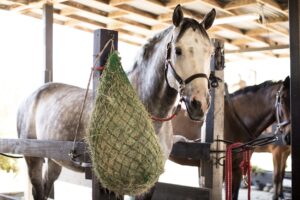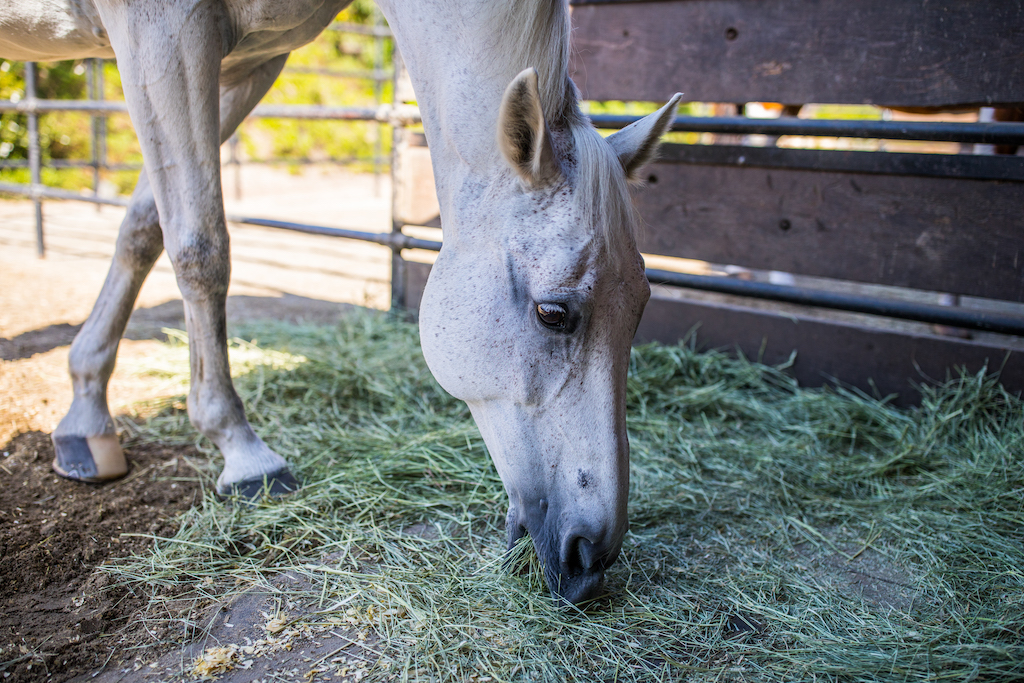Gut health is an important part of your horse’s overall health and well-being.
Even when feeding high-quality hay or feed, determining exactly how much and how often to feed your horse, or whether you should add supplements, can be difficult. Understanding a few things about your horse’s digestive system can help.
Some Facts to Chew On
A horse’s stomach holds only 2-4 gallons
For such a large animal, horses have a relatively small stomach and can hold only 2-4 gallons of material. A small stomach limits the amount a horse can eat at one time, making it all the more important to feed frequently in order to provide enough calories, vitamins, and nutrients for optimal health.
The equine digestive system continuously breaks down food
Frequent feeding is necessary to keep up with the constant production of enzymes like pepsinogen and gastric acid that are used to break down food. Horses are natural-born foragers, spending 16-18 hours per day grazing on green pasture. As a result, the equine digestive system is in a constant state of readiness, always prepared for digestion. The stomach does not have the ability to turn off the production of gastric acid. Therefore, it’s important for your horse to eat often and in the right amounts, to ward off problems such as gastric discomfort and gastric ulcers, which can be caused by the presence of excess gastric acid in the stomach.
The horse digestive system is unique
Horses have a monogastric digestive system. This means that they have a stomach with one compartment. When combined with the small intestine, this portion of the digestive tract is often referred to as the foregut. The hindgut includes the cecum and large and small colons and is where microbial fermentation takes place. Unlike cows and other ruminant animals, horses do not chew cud, meaning that they do not use regurgitation and rechewing to help increase digestion of their food. In fact, horses are physically unable to regurgitate or vomit.
The big difference between horses and ruminants is that in the horse the food enters the gastric stomach first before traveling through the small intestine to the sites of hindgut microbial fermentation. Conversely, in the ruminant, the food enters the rumen first where microbial fermentation takes place before passing to the gastric stomach and small intestine.
Horses don’t have gallbladders. Most vertebrate animals have a gall bladder that stores and secretes bile in order to break down and absorb fats. Although horses don’t have a gallbladder, their bodies are well equipped to metabolize fats. Bile is constantly secreted by the liver directly into the small intestine, making it available to break down this important source of energy 24/7.
Equine Digestion: Let’s Break it Down
“After eating, if your horse is finding things other than food to chew on, he may be trying to buffer excess stomach acid.”
Chewing
Horse digestion begins with chewing which stimulates the production of saliva. In fact, saliva is only produced when chewing. Saliva contains bicarbonate, which acts as a natural antacid and buffers stomach acid, and an enzyme (salivary amylase) that begins to break down starch. The more frequently the horse chews the more he is able to buffer the constantly secreted stomach acid.
Foregut
Chewed particles move down the esophagus to the stomach and then on to the small intestine. Stomach acid (hydrochloric acid) activates the enzyme pepsin which is responsible for the digestion of protein. This acid also destroys harmful microorganisms that your horse may ingest from the environment.
Stomach acid helps aid the immune system. Long-term use of antacids or ulcer medicine may suppress the immune effect.
Other enzymes in the small intestine break down proteins, fats, and carbohydrates. Once broken down into small molecules, they are absorbed in the bloodstream as amino acids (from proteins), fatty acids (from fat), and different sugars including glucose (from simple carbohydrates). These molecules are stored for later use or used for building body tissues such as muscles, hair, skin, hooves, etc. Vitamins and many minerals are also absorbed from the small intestine. Keeping your horse’s digestive system healthy ensures proper nutrient absorption, muscle development, increased energy, and improved overall health.
Hindgut
Ideally, complex carbohydrates (think fiber) will be all that is left to digest as the remaining feed moves to the hindgut (cecum and colon) to ferment. This is where the “good bacteria” live. They need a PH-neutral environment for optimal fermentation to occur. The addition of prebiotics and probiotics can help assist with the breakdown of fiber and support the growth of healthy microbes.
For healthy digestion, feeds high in sugar and starch (like cereal grains and molasses) should be used in moderation so that digestion remains in the foregut, rather than overflowing to the hindgut. This helps the hindgut maintain a balanced pH which is optimal for the fiber fermenting bacteria. Grain in the hindgut can cause rapid fermentation and a pH that is too acidic.
“Drinking plenty of water aids in proper digestion.”
There are many tight turns or flexures in the horse’s hindgut. If your horse does not chew his food properly or drink enough water, the feed can become trapped in these narrowed locations which can lead to impaction and discomfort. The microbes in the hindgut generate B vitamins and vitamin K. These vitamins along with the by-products of the fermentation process (volatile fatty acids) are absorbed from the large colon to be used by the horse. Water is absorbed from the small colon resulting in the formation of the fecal balls we are all familiar with.
Follow Your Gut
Every horse is unique, but you instinctively know when your horse is not in optimal health. Follow your gut when monitoring your horse’s digestive health and when considering any adjustment to feed and nutritional supplements. Knowing more about your horse’s digestive system can help when consulting a nutritionist or veterinarian, and will ultimately result in making the best nutritional choices for your horse.
Optimize your horse’s gut health and consider the following:
Feed
A healthy equine digestive system starts with good nutrition. Access to good-quality hay is important. Once hay is cut it loses some of its nutrient value over time. Testing your horse’s hay can give you more information about its nutrient content and indicate which nutrients may be lacking.
Dosage
The equine digestion system is constantly preparing for digestion, so create a feeding routine that is similar to natural grazing. The equine stomach becomes mostly empty about 6 hours after being fed, so ideally you want to feed at least every 6 hours. Hay and feed should be fed according to weight, not volume.
“A safe guideline for administering hay is to feed at least 1.5% of body weight per day or about 15 lbs. of hay per day for a 1000 lb. horse.”
Ideally, your horse would have access to free-choice grass or hay so that the stomach is not empty for long periods of time. However, this will cause some horses to gain too much weight. For these horses using a slow feeder to make their feed last longer can be a useful tool.

Water
Make sure your horse has enough water to aid in proper digestion and overall comfort. Water should be clean, cool, and palatable.
Supplements
Pay close attention to your horse’s nutritional intake and add a digestive support supplement when needed. The equine digestive system is dependent upon a healthy population of beneficial microorganisms to maintain overall gut health. Adding a daily prebiotic and probiotic can help support and replenish these “good bugs”.


